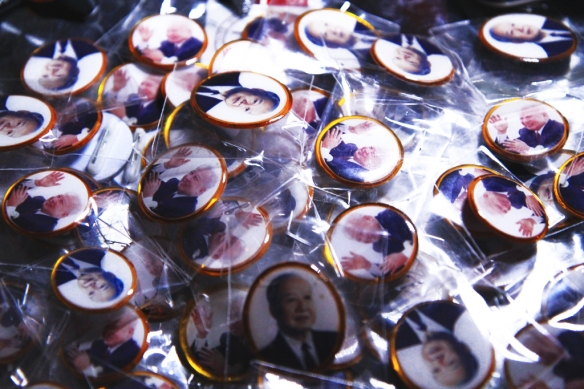
Bloggers are about the same everywhere, I guess. Fractious and noisy. Exuberant, opinionated, occasionally make questionable clothing choices. Might have been considered “weird” in school. Vanguards of social revolution and change—that too. You ignore them at your own peril.
This particular motley pack of Asia bloggers convened at Build Bright University, a small college of something or another outside Siem Reap, placed in the middle of what appeared to be a loosely residential neighborhood, mixed with a small dairy-and-water-lily farm. The bloggers came from 12 Asian countries, a smattering hailing from further afield (including yours truly). Their ages ranged from 14 to in their 70s. Many were professionals, some were students, some had even achieved the holy grail of professional blogging. All fervently wanted to geek out.

Siem Reap is the small city adjacent to Angkor Wat, and is by far the most heavily touristed place in Cambodia—a fact not lost on the attendees, who gathered to watch sunsets, sunrises, and things in between at the archaeological ruins. Many of them were travel bloggers, after all. Catnip.
It is worth pointing out the disconnect between Cambodia’s ubiquitous small, naked children, lotus ponds and wooden, ramshackle homes—right outside the conference—with a cosmopolitan group of tech geeks, most sporting expensive equipment.

However: I don’t see this as some sort of fell indicator of social injustice. The fact that such a gathering is happening in Cambodia at all is, in my estimation, a remarkable indicator of social change.
Further: the Cambodian could have swiftly squashed this gathering if they so chose, but it didn’t. In fact, Cambodian Minister of Information Khieu Kanharith attended and gave out awards on Monday, the final day of the conference. Blogger and event organizer Kounila Keo told me that she ran the schedule of the event by him—including multiple named workshops on Internet freedom—and he expressed no apprehension.
Would that happen in China or Vietnam? I don’t think so.
Sadly, Cambodians seem to get very little love from the mainstream media. They have few choices: they are genocidal and backwards. They are Noble Savages who smile a lot and have not quite got the hang of industrialization, bless them. But the Cambodian bloggers I know are not content to conform to this heat-addled stereotype. They firmly believe that technology and free speech will eventually win out against the forces that are arrayed against them.

And that goes for the other Asian bloggers in attendance, many of whom reside in often-overlooked but swiftly developing nations . Did you know that Filipinos send around 2 billion text messages a day, the most in the world? Or that Indonesians are the world’s biggest users of Twitter, and have collectively created over 5 million blogs? That in only 2 years of rapid change, Myanmar is approaching three percent Internet penetration?
These are all remarkable stats. These are all somewhat little-known stats. This is why I am glad I attended Blogfest Asia 2012.

“We somehow have the perception the world only goes on in Europe and the United States, when in fact many things are happening in Southeast Asia,” observed SPIDER (Swedish Program for ICT in Developing Regions) board member and event speaker David Isaakson to me.
“It’s amazing that so many people are using this [social media] in countries with a situation with less freedom of expression or government control,” he added. “Social media becomes even more important when you don’t see unbiased reporting in national channels.”
Definitely. Citizen journalists, as we’ve seen in the Middle East, step up to fill the gap when the mainstream media either can’t get in, or does’t have the funding or motivation to cover stories considered to be of minimal international interest. For the first time, bloggers—even those who are operating under considerable danger—have the means to speak out against oppression in a very visible way. This scares the crap out of governments, and empowers tech-savvy people who might formally have been relatively helpless in the arena of speaking-truth-to-power. Ignore them at your own peril.
That simple reality ended up politicizing the event to some extent, perhaps more than the planners had anticipated. Almost every nation represented had an axe to grind: that people from all these nations were then able to come together and compare notes on what they’re up against is heartening in the extreme.

Meanwhile, the Cambodians weren’t shy about expressing their trepidation over the planned, feared Internet cyber-crimes draft law. The government claims it’s to protect against terrorism, but the bloggers are much more suspicious: they think the law will serve as a convenient method of cracking down on dissidents, much in the fashion of Vietnam or Thailand.
Cambodians currently enjoy one of the freest networks in Southeast Asia, and they are fully aware of the options this accords them: although most attendees were willing to play a bit of wait-and-see, they also were quite vocal about their apprehension.
Fai Suluck from Thailand discussed the situation in her own country, where strict lese majeste laws and fear stemming from recent military unrest have kept bloggers relatively silent.
She described the law and its dampening affects on freedom of speech in Thailand to the attentive crowd, then issued a warning: “…For countries about to have this law passed, yes: go against it.”
Note taken.



















